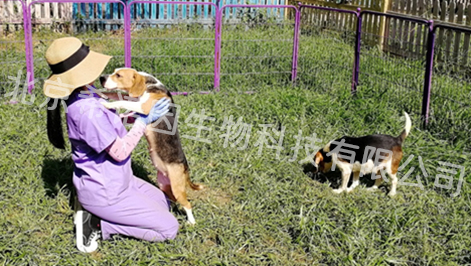点击展开
Gene editing dog model
Gene editing dog model
Background
1 Autism spectrum disorder
Autism Spectrum disorder (ASD) is found in all ethnic groups, with an average prevalence of about 1%. ASD is a type of neurodevelopmental disease, in which different patients with autism have great phenotypic heterogeneity inautonomous survival, cognitive and language abilities, and complications (Lord et al., 2000). There are mainly two core symptoms, namely, social communication disorders and rigid and repetitive behaviors. These symptoms appear in early childhood and affect the ability to live daily life. Autism is affecting more and more families, causing great financial burden and mental stress, and has become a public health problem. Therefore, we need to actively search for the causes of autism, build animal models according to the pathogenic genes of autism, clarify the pathogenesis of autism, and provide scientific basis for effective diagnosis and early intervention of the disease.
2 The SHANK3 gene
SHANK3 is one of the best-studied autism genes, and mutations in this gene account for about 1% of cases of autism spectrum disorder. Large deletions of the SHANK3 region lead to Phelan-McDermid Syndrome (PMS). The size of missing fragments in patients with PMS can range from 0.1 Mb to 10 Mb. The main clinical symptoms are hypotonia, developmental delay, speech loss or lag, and intellectual impairment. 75% of patients are also diagnosed with autism spectrum disorder.
By analyzing the whole genome sequence of domestic dogs, we found that Shank3 genetic structure in domestic dogs has 22 exons similar to mouse and human. Exon 21 of Shank3 gene in the domestic dogs encodes a proline-rich conserved region, which is a hot spot for mutations in autism. Therefore, gene editing was performed on exon 21 (sgRNA 2 and 3), and on two sites of exon 5 and 21 (sgRNA 1 and 3) to induce invalid alleles of Shank3. At present, the company has F0 generation dogs with deleted Shank3 exon 21 fragment and 33Kb exon 5~21 large fragment, and a large number of heterozygous F1 generation dogs of different gene types.

Results of F0 generation of model dogs
1 Complications of autism
1) Motor ability: Treadmill experiment proved that all mutants had different degrees of motor coordination impairment, in addition, all mutants could not climb stairs, and all mutants had abnormal motor coordination ability.
2) Activity and sleep: Increased nocturnal activity and fragmented sleep were found in Shank3 mutant dogs after 24-hour activity monitoring by activity monitor; Sleep duration is shortened and sleep quality is poor.
2 Core symptoms of autism
1) Dog-to-dog socializing:
Three-box experiment: The results of the classic same-type social "three-box" experiment showed that the mutant dogs spent significantly less time socializing with strangers (sniffing and inviting them to play), and even showed signs of social stress such as tail clipping and withdrawal. The mutant had defects in dog-to-dog social ability.
2)Dog-to-huamn socializing:
Social interaction between human and dog in cage breeding: Mutant dogs can't follow the direction of human walking, with poor following ability, significantly reduce the sniffing and licking time of human hands, and even show signs of social pressure such as tail clipping and withdrawal. Mutant has defects in social ability with human.
Social interaction between human and dog in open environment: Mutant dogs have significantly reduced social interaction with humans and spend most of their time sniffing the ground and rolling away from people.

3) Rigid behavior:
In the absence of skin inflammation, the mutants' self-scratching, licking and planing behaviors increased significantly, and their rigid behaviors were obvious.
Both homozygous F0 generation and heterozygous F1 generation of Shank3 gene editing dogs had social defects (reduced social time and increased social pressure), stereotyped repetitive behaviors and other core symptoms of autism in the dog-to-dog social interaction (the classic "three boxes" experiment) and dog-to-human social interaction. In addition, the model dogs also have reduced motor ability, sleep disorders and other symptoms. The above phenotypes are ideal animal models for the study of autism, which are similar to the clinical phenotypes of children with autism.
3 Population quantity
F0\F1\F2 a total of 80;
4 Model application
1.Use model dogs to carry out relevant research topics, and conduct in-depth research on the pathogenesis of autism through behavioral phenotype, brain imaging and molecular detection analysis;
2.Use model dogs to carry out relevant research topics, and conduct in-depth research on the pathogenesis of autism through behavioral phenotype, brain imaging and molecular detection analysis;
3.Use model dogs to conduct relevant drug effectiveness evaluation and new drug research and development experiments:
1) Evaluate the effect of medication on stereotyped behavior in autism;
2) Assess the effect of medication on social dysfunction;
3) Evaluate the improvement of sleep, motor ability and attention disorders;
4.Use model dogs to conduct non-drug therapy effectiveness experiment and evaluation
1. Evaluate the therapeutic effects of medical instruments and rehabilitation physiotherapy instruments on autism;
2. Evaluate the therapeutic effect of surgical operation and eeg intervention on autism;
3. Evaluate the therapeutic effect of stem cells on autism;
4. Evaluate the therapeutic effect of behavioral education such as social training on autism.